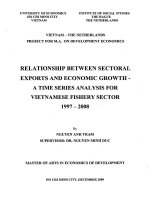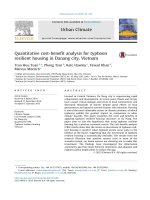Energy analysis for island formation on stranski krastanow systems
Bạn đang xem bản rút gọn của tài liệu. Xem và tải ngay bản đầy đủ của tài liệu tại đây (1.12 MB, 104 trang )
Acknowledgement
I would like to express my gratitude to all the persons who made this thesis
possible.
First of all, I gratefully acknowledge my supervisor, Dr. Chiu Cheng-hsin for
his invaluable guidance and support. His enthusiasm and active research interests
are the constant source of inspiration to me. During the course of this work, I
have learnt from him on how to do research work.
I would also like to thank our group members, Huang Zhijun, Wang Hangyao
and C-T Poh, for their instruction and discussions in the research, sharing of their
research experiences and all the assistance to me.
Last but not least, I would like to thank my parents and my friends, for their
care and encouragement during all my efforts and for their supporting all of my
decisions.
i
Table of Contents
Acknowledgement
i
Table of Contents
ii
Summary
vi
List of Figures
viii
1 Introduction
1.1
1.2
1
Experimental Observation . . . . . . . . . . . . . . . . . . . . . .
1
1.1.1
Island Formation . . . . . . . . . . . . . . . . . . . . . . .
2
1.1.2
Prepyramid to Pyramid Transition . . . . . . . . . . . . .
4
Theoretical Study for Island Formation . . . . . . . . . . . . . . .
5
1.2.1
Boundary Perturbation Method . . . . . . . . . . . . . . .
5
1.2.2
Energy Analysis for Island Formation . . . . . . . . . . . .
8
ii
Table of Contents
2 Model and Methodology
2.1
2.2
iii
11
A Continuum Model for the SK Film-Substrate System . . . . . .
11
2.1.1
The Geometry of the Island . . . . . . . . . . . . . . . . .
11
2.1.2
The Total Energy of the SK System . . . . . . . . . . . . .
12
The First-Order Boundary Perturbation Method . . . . . . . . . .
15
2.2.1
Description of the System . . . . . . . . . . . . . . . . . .
16
2.2.2
The First-Order Boundary Perturbation Method . . . . . .
19
2.2.3
The Function Ψ(x0 ) . . . . . . . . . . . . . . . . . . . . .
22
2.2.4
The Numerical Implementation . . . . . . . . . . . . . . .
23
3 The Critical Thickness of the SK Transition
26
3.1
Introduction . . . . . . . . . . . . . . . . . . . . . . . . . . . . . .
26
3.2
Model . . . . . . . . . . . . . . . . . . . . . . . . . . . . . . . . .
28
3.2.1
The Geometry of the Island . . . . . . . . . . . . . . . . .
28
3.2.2
The Total Energy Change ∆E . . . . . . . . . . . . . . . .
30
The Critical Thickness for Spontaneous Island Formation . . . . .
34
3.3.1
Numerical Result . . . . . . . . . . . . . . . . . . . . . . .
34
3.3.2
The First Critical Thickness . . . . . . . . . . . . . . . . .
36
The Critical Thickness for Surface Undulation Model . . . . . . .
38
3.4.1
Model . . . . . . . . . . . . . . . . . . . . . . . . . . . . .
38
3.4.2
The Total Energy Change ∆E . . . . . . . . . . . . . . . .
39
3.4.3
The Second Critical Thickness . . . . . . . . . . . . . . . .
44
3.3
3.4
Table of Contents
4 The Formation of Trancated Pyramid Islands
iv
47
4.1
Introduction . . . . . . . . . . . . . . . . . . . . . . . . . . . . . .
47
4.2
Model . . . . . . . . . . . . . . . . . . . . . . . . . . . . . . . . .
49
4.2.1
The Geometry of the Island . . . . . . . . . . . . . . . . .
49
4.2.2
The Continuum Model for the SK System . . . . . . . . .
50
Island Formation on a Thick Film via Surface Undulation . . . . .
52
4.3.1
A Typical Numerical Result . . . . . . . . . . . . . . . . .
52
4.3.2
Analytical Results . . . . . . . . . . . . . . . . . . . . . .
55
Island Formation on a Thin Film via Surface Undulation . . . . .
65
4.3
4.4
5 The Cooperative Formation
71
5.1
Introduction . . . . . . . . . . . . . . . . . . . . . . . . . . . . . .
71
5.2
Model . . . . . . . . . . . . . . . . . . . . . . . . . . . . . . . . .
73
5.2.1
The Geometry of the Island . . . . . . . . . . . . . . . . .
73
5.2.2
The Variation of the Total Energy Change ∆E with the
Trench Depth At . . . . . . . . . . . . . . . . . . . . . . .
75
The Total Energy Change ∆E . . . . . . . . . . . . . . . .
76
The Cooperative Formation on a Thick Film . . . . . . . . . . . .
79
5.3.1
The Total Energy Change ∆E . . . . . . . . . . . . . . . .
79
5.3.2
A Typical Numerical Result . . . . . . . . . . . . . . . . .
80
5.3.3
Analytical Results . . . . . . . . . . . . . . . . . . . . . .
81
5.2.3
5.3
5.4
The Stability of a Pyramid Island on a Thin Film against Trench
Formation . . . . . . . . . . . . . . . . . . . . . . . . . . . . . . .
83
Table of Contents
v
6 Conclusion
87
Bibliography
91
Summary
The SiGe on Si(001) system has been extensively studied for understanding the
heteroepitaxy of the system and there is a wide interest in employing the “selfassembled quantum dots” grown on the system in the nano-technology. In this
thesis, we study the formation of the SiGe nano-islands on the Si substrate from
the energy point of view. Our energy analyses are based on a continuum threedimensional model for the SiGe/Si system, and the analyses are carried out by
employing the first-order boundary perturbation method to calculate the energy
change during the island formation process. Three important issues in the island
formation process are investigated. The first one is the critical thickness of the
wetting layer below which the formation of islands is completely suppressed. The
second issue is the shape transition from a shallow bump to a faceted pyramid, and
of particular interest is the dependence of the shape transition on the island size,
the island shape and the film thickness. The third issue examined in this thesis
focuses on the cooperative formation, which is characterized by the development
of trenches surrounding the pyramid island after the bump-pyramid transition. It
is demonstrated that it is always energetically favorable for the trench to develop
on a thick film after the bump-pyramid transition, while the trench formation can
vi
SUMMARY
be suppressed on a thin film.
vii
List of Figures
1.1
A schematic diagram of the formation of SiGe islands formation on
Si(001) substrate . . . . . . . . . . . . . . . . . . . . . . . . . . .
1
2.1
A schematic diagram of the formation of a facet island . . . . . .
11
2.2
A schematic diagram of a facet island on an SK film-substrate system 16
2.3
A schematic diagram of the illustration of the trapezoidal area for
the integral of the function I . . . . . . . . . . . . . . . . . . . . .
3.1
A schematic diagram of an SK film-substrate system containing a
trancated pyramid island on a flat wetting layer . . . . . . . . . .
3.2
23
29
The variation of the function U (η) with the width ratio η for a
trancated pyramid island . . . . . . . . . . . . . . . . . . . . . . .
31
3.3
The critical thickness for the trancated pyramid island formation .
34
3.4
The variation of the first critical thickness H1 with the width ratio η 37
3.5
The variation of the surface energy density with the angle φ . . .
3.6
The variation of the second critical thickness H2 with the width
ratio η . . . . . . . . . . . . . . . . . . . . . . . . . . . . . . . . .
viii
42
45
List of figures
4.1
ix
A schematic diagram of an SK film-substrate system containing a
trancated pyramid island on a flat wetting layer . . . . . . . . . .
4.2
49
The contours of the total energy change ∆E as a function of the
island volume V and the angle φ for the island formation on a thick
film . . . . . . . . . . . . . . . . . . . . . . . . . . . . . . . . . . .
52
4.3
Numerical results of the island morphology transition . . . . . . .
54
4.4
The variation of the critical island volume for the island morphology transition Vcr with the angle φ0 . . . . . . . . . . . . . . . . .
4.5
62
The contours of the critical island volume for the island morphology
transition Vˆcr as a function of the surface energy density ratio γ2 /γ1
and the angle φ0
4.6
. . . . . . . . . . . . . . . . . . . . . . . . . . .
The domain (η, V ) of the total energy change ∆Efacet < 0 for a
facet island formation on a thick film . . . . . . . . . . . . . . . .
4.7
63
64
The contours of the total energy change for the island formation
on a thin film ∆E as a function of the island volume V and the
angle φ . . . . . . . . . . . . . . . . . . . . . . . . . . . . . . . . .
4.8
The variation of the minimum facet angle φmin with the island
volume V for the case where H + l = 4Hcr . . . . . . . . . . . . .
4.9
66
67
The domain (η, V ) of the total energy change ∆Efacet < 0 for a
facet island on a thin film . . . . . . . . . . . . . . . . . . . . . .
68
4.10 The variation of the critical volume Vcr with the normalized film
thickness (H + l)/Hcr for the formation of island on a thin film
.
70
List of figures
5.1
A schematic diagram of the cooperative formation . . . . . . . . .
5.2
The variation of the strain energy function Uc (ηc ) with the width
ratio ηc and the derivative Uc (ηc ) as a function of ηc . . . . . . . .
5.3
x
74
77
The contours of the total energy change ∆E for the trench formation as a function of the island volume V and the width ratio
ηc . . . . . . . . . . . . . . . . . . . . . . . . . . . . . . . . . . . .
5.4
The variation of the critical volume VT and the equilibrium trench
shape ηc with G3 /(tan φ)5 for the two trench growth modes . . . .
5.5
81
84
The contours of the driving force F0 = 0 and the contours of the
total energy change for a pyramid island ∆Epyramid = 0 . . . . . .
85
Chapter 1
Introduction
1.1
Experimental Observation
Figure 1.1: A schematic diagram of the formation of SiGe islands on Si(001) substrate
The epitaxial growth of a Ge or a SiGe alloy film on the Si(001) substrate
has been intensely studied for many years, driven by the desire to create SiGe heterojunction superlattices, which would form the basis of optoelectronic
devices (Moriarty and Krishnamurthy., 1983; Pearsall et al., 1987). The growth
of the SiGe/Si(001) system follows the Stranski-Krastanow(SK) mode, which is
one of the three basic growth modes for thin film. In the SK mode, Ge or SiGe
1
Chapter 1: Introduction
2
firstly grows in a layer-by-layer mode for several layers, and the flat layers are also
called the “wetting layer” (The wetting layer thickness is about 3 to 4 monolayer in
the case of a Ge film on a Si substrate.). After the formation of the wetting layer,
three-dimensional coherent islands form on the surface of the wetting layer (Tsaur
et al., 1981; Asai et al., 1985). The island formation pathway is illustrated in Fig.
1.1. It is now well understood that the film develops into islands in order to
reduce the elastic energy accumulated in the strained epilayer, because of the
4.2% lattice mismatch between Ge and Si.
1.1.1
Island Formation
Ge islands were first observed as {105}-faceted rectangular pyramids by Mo et
al. (1990). In their work, meta-stable three-dimensional clusters were discovered.
The small clusters, which are called “hut” clusters, have a prism shape with the
same atomic structure on all four facets. Their study also showed that the clusters’
principal axes are strictly along two orthogonal <100> directions and all of the
four facets are determined to be {105} planes. The {105} plane can be simply
understood as a vicinal (001) surface that tilts by 11.3 ◦ along <100>.
Similar pyramid islands were observed by Tomitori et al. (1993) and Hornvon Hoegen et al. (1993) when growing Ge on Si. In addition to the Ge film,
the pyramid islands were also found on the SiGe film. For example, Pidduck et
al. (1992) reported the formation of <100> oriented islands, with sidewall angles
being in the range between 9 and 16 ◦ when they grew Si1−x Gex on Si(100) with
x=0.20-0.26.
Chapter 1: Introduction
3
A rich body of relevant works showed that the pyramid islands may undergo
some shape transitions as the island size increases. Tersoff and Tromp (1993)
studied islands formation of Ag on Si(001) and found that islands would adopt a
shape of long wire instead of a compact, symmetric shape if the island exceeded a
critical size, and that the aspect ratio of the wire could be greater than 50:1. The
“quantum wires” were observed later in several systems, including GaAs on Si
(Ponce and Hetherington, 1989), Au on Mo(111) and Au on Si(111) (Mundschau
et al., 1989), and Au on Ag(110) (Rousset et al., 1992).
Subsequent studies showed that, in equilibrium, small islands are square pyramids, while larger islands develop a more complex multi-facet shape, usually called
“dome” shape (Lutz et al., 1994; Floro et al., 1999; Ross et al., 1999).
Instead of finding elongated huts (Tersoff and Tromp, 1993), Lutz and coworkers observed not only {105} facets but also {311} and {518} facets on the
surfaces of strained Si1−x Gex films with x=0.15-0.35 (Lutz et al., 1994). The
growth sequence begins with the shallow {105} facets, followed by the appearance
of steeper facets, oriented on {311} and {518} crystal facets.
Ribeiro and co-workers(1998) determined that in the Ge/Si system the smaller
nanocrystals were mainly square-based pyramids and the larger nanocrystals were
multifaceted domes. The major dome facets they observed are {113} and {102}
planes. The shape of the dome can be described as a combination of two nearly degenerate pyramids rotated 45 ◦ with respect to each other and with the sharp apex
blunted. Floro et al. (1999) found that the morphological evolution of Si1−x Gex
film at low mismatch strains is qualitatively consistent with that of a pure Ge film
Chapter 1: Introduction
4
on Si(001). The Si1−x Gex films with strains less than 1% undergo the StranskiKrastanow transition to form islands, followed by the emergence of the {105}
faceted hut clusters and the transformation of the huts into domes characterized
by the {311} and {201} facets.
Further work by Ross and co-workers showed clearly that each island would
undergo several distinct configurations during the growth. The earliest stage of
growth is a surface roughening process during which the slope of the surface
increases until the {105} facets appear (Ross et al., 1999). After a dense array of
pyramids form, the islands coarsen, and eventually transform into domes when the
island size is sufficiently large. The transition from pyramids to domes involves
two stages: Firstly, the {311} facets appear at the four corners of the pyramids.
The islands, called the transitional pyramid, are characterized by an octagonal
base. The second stage is the appearance of the {15 3 23} facets[which is close
to the {518} facets reported in (Lutz et al., 1994)].
1.1.2
Prepyramid to Pyramid Transition
Prepyramids, first reported in (Chen et al., 1997), refer to the small islands that
form prior to the emergence of the pyramids. The prepyramids are characterized
by a smooth shape without a specific facet, and they appear to be precursors to
the well studied pyramids. Chen et al.’s results were later confirmed in (Vailionis
et al., 2000), which presented clear experimental evidence that two-dimensional
islands on the wetting layer first evolve into small rounded three-dimensional
islands and then transform into {105}-faceted pyramids with <100> oriented
Chapter 1: Introduction
5
rectangular bases. In spite of the inspiring experimental findings, the nature of
these islands and their role in the growth process have not been fully understood.
Studying the morphological evolution of the Si1−x Gex layers on Si(001) by
STM, Rastelli and von K¨anel (2003) postulated that the prepyramid-pyramid
transition involved the nucleation of facets in the middle of the prepyramid surface
and the subsequent growth of the facets over the whole prepyramid surface.
In contrast to Rastelli and Von Kanel’s result, Sutter and Lagally (2000)
demonstrated that nucleation is not involved in the formation of the faceted
three-dimensional islands on the Si1−x Gex /Si systems with a low Ge concentration. Instead, the facet islands can form via a barrierless and continuous process
involving shallow bumps. The slope of these precursor bumps increases continuously until the bumps transform into faceted islands. The experiments of Tromp
et al. also showed that the growth of Si1−x Gex islands does not evolve nucleation
when the Ge concentration x is between 0.2 and 0.6. These two groups’ studies
both presented that, at least in some range of temperature and alloy composition,
islands can evolve continuously from surface ripples.
1.2
1.2.1
Theoretical Study for Island Formation
Boundary Perturbation Method
When studying the formation of nano-crystalline islands on the heteroepitaxial
film-substrate systems, one question often encountered is to calculate the strain
energy change during the formation process. Typical numerical methods such
Chapter 1: Introduction
6
as the finite element method(FEM) (Freund and Jonsdottir, 1993; Floro et al.,
1998, 1999) for linear elasticity problems can be employed to solve the question;
the results are accurate and there is no fundamental difficulty in calculating any
island shape.
The limitation of the FEM approach is that the numerical efficiency is not high
enough to allow calculating a great many cases within reasonable time, especially
in the case of three-dimensional islands. The limitation makes it expensive to use
the FEM approach to examine problems that involve more than two variables to
describe the island shapes. There are several examples of these types of problems:
the trancated pyramids with a rectangular base (Tersoff and Tromp, 1993), the
equilibrium shapes of two-dimensional faceted islands (Daruka et al., 1999), and
the pyramid islands with a round top during the bump-pyramid transition (Tersoff
et al., 2002). It is therefore desirable to develop methods to estimate the strain
energy density on the island surfaces as well as the strain energy associated with
the formation of the islands.
Gao (1991) proposed the first-order boundary perturbation method for the
elasticity problem of a two-dimensional strained solid with a wavy surface. The
method is based on Muskhelishvilli’s complex variable potentials for two-dimensional
elasticity solutions and it is accurate to the first-order of the slope of the surface.
The method can be applied to any smooth island profile, including cosine curves
and rounded islands on a flat surface . The method can also be extended to
anisotropic solids (Gao, 1991b) and film-substrate systems with different elastic
constants between the substrate and the film.
Chapter 1: Introduction
7
Tersoff and Tromp (1993) suggested a different perturbation approach. In
their approach, which is in essence identical to Gao’s method, the effects of an
island surface on the elasticity solution can be approximated by a distribution of
surface traction on the flat surface of a semi-infinite solid. Applications of the approach include elastically dissimilar film-substrate systems with three-dimensional
undulating surface (Freund and Jonsdottir, 1993) and two-dimensional smooth islands (Spencer and Tersoff, 1997).
Except for the smooth profiles, the surface traction approach can also be
employed for the cases of faceted islands, by ignoring the weak singularity at the
edges between the islands and the flat surface (Tersoff and Tromp, 1993), and
the result is accurate to the first-order of the faceted slope. The approach can be
employed not only for two-dimensional faceted islands (Daruka et al., 1999; Tersoff
et al., 2002), but also for three-dimensional ones (Tersoff and Tromp, 1993). Even
in the case of complicated shapes, the calculation of the strain energy of threedimensional faceted islands is still straightforward. However, the available formula
involves a four-dimensional integral, which can be extremely demanding from the
computation point of view. This difficulty limits the application of the surface
traction approach to studying the variation of the strain energy with the faceted
island shapes.
A different formula for estimating the strain energy of a three-dimensional
faceted island on an elastically similar film-substrate system is presented in (Chiu
and Poh, 2004). The most important improvement of the new formula is that
it only needs two-dimensional integral when evaluating the island strain energy,
Chapter 1: Introduction
8
which greatly reduces the calculation time to a more acceptable duration. The
formula will be employed in this thesis to calculate the strain energy change during
the island formation.
1.2.2
Energy Analysis for Island Formation
Tersoff and LeGoues (1994) presented a widely used theory for the transition
from two-dimensional layer to the faceted three-dimensional islands, which assumed that these islands form via a three-dimensional nucleation process. Threedimensional island nucleation is characterized by a misfit-dependent critical volume above which three-dimensional islands are stable against decay towards a
planar film, and the nucleation is an activated process involving activation energy (Tersoff and LeGoues, 1994).
Tersoff et al. (2002) proposed barrierless formation of tiny prepyramid islands
by using a simple two-dimensional model. A simple assumption was employed that
the surface-energy anisotropy allows all orientations near (001), with the first facet
being (105). With this assumption, they predicted that tiny prepyramid islands
would form without nucleation barrier and that the islands would be unfaceted.
As islands increase in size, the prepyramids would undergo a first-order shape
transition. The results suggest that there are two critical volumes, V2 and V3 , in
the process. The quantity V2 is the volume at which a first-order shape transition
can happen (from small smooth islands to faceted islands) and V3 denotes the
volume at which the slope of the island reaches the stability limit. When V>V3 ,
the only stable shape is a faceted island with a rounded top.
Chapter 1: Introduction
9
Tersoff et al. (2002) analyzed the energy change of island formation. They
found that there is no energy barrier to the nucleation of an island since the energy
is a monotonically decreasing function of size even for arbitrarily small islands.
A growing island will remain stable and unfaceted until the size is up to V2 at
which point the island becomes meta-stable and in equilibrium it transforms to
a faceted shape. However, the island may still grow continuously with unfaceted
shape because there is an energy barrier for the first-order transition. The energy
barrier decreases with increasing size. The energy barrier decreases to zero and
the unfaceted island becomes unstable against shape transition to a facetted one
as the size reaches V3 .
Tersoff’s experimental and theoretical investigations have made remarkable
progress in the understanding of island formation. The picture of island formation
is explicit and the transition between different island shapes is clearly illustrated
through energy analysis. However, limitations still exist. In the previous work,
only a two-dimensional mode was employed to calculate the energy change. Also,
the development of trenches surrounding the pyramid islands after their formation
has not been fully understood.
In this thesis, we study the formation of the SiGe nano-islands on the Si
substrate from the energy point of view. Our energy analyses are based on a
continuum three-dimensional model for the SiGe/Si system, and the analyses are
carried out by employing the first-order boundary perturbation method to calculate the total energy change during the island formation process. The total energy
includes the strain energy, the surface energy, and the film-substrate interaction
Chapter 1: Introduction
10
energy. Three important issues in the island formation process are investigated in
this thesis. The first one is the critical thickness of the wetting layer below which
the formation of islands is completely suppressed. The second issue is the shape
transition from a shallow bump to a faceted pyramid, and of particular interest is
the dependence of the shape transition on the island size, the island shape and the
film thickness. The third issue examined in this thesis focuses on the cooperative
formation, which is characterized by the development of trenches surrounding the
pyramid island after the bump-pyramid transition. It is demonstrated that it is
always energetically favorable for the trench to develop on a thick film after the
bump-pyramid transition, while the trench formation can be suppressed on a thin
film.
The thesis is outlined as follows: Chapter 2 describes the model for the filmsubstrate systems examined in the thesis and the methodology for carrying out
the energy analysis. Chapter 3 presents the results of the critical thickness for
island formation. Chapter 4 focuses on the formation of islands via the surface
undulation mode, followed by discussions of the trench formation in Chapter 5.
The thesis is concluded in Chapter 6.
Chapter 2
Model and Methodology
2.1
A Continuum Model for the SK Film-Substrate
System
2.1.1
The Geometry of the Island
Figure 2.1: A schematic diagram of the formation of a facet island.
Fig. 2.1 depicts the film-substrate system that is employed to investigate the
island formation process in this thesis. The substrate is assumed to be a semi11
Chapter 2: Model and Methodology
12
infinite solid, while the film consists of a flat wetting layer of thickness H and a
facet island which may contain several types of facets. The facets are denoted as
{Γ1 ,Γ2 ,...,ΓN } where N is the number of facets of the island. The angles between
the facet and the wetting layer surface are called the facet angle and are denoted
as {φ1 ,φ2 ,...φN }.
The facet island is thought to develop from the flat wetting layer under a
mass-conserved shape transformation process as shown in Fig. 2.1. The total
energy change during the island formation process is called the energy of the
island. Similarly, the energy of other structures on the film-substrate system, for
example the island with a surrounding trench, refers to the total energy change
as the structure develops from a flat wetting layer by the mass-conserved process.
2.1.2
The Total Energy of the SK System
The total energy of an SK system consists of the strain energy, the surface energy,
and the film-substrate interaction energy (Tersoff and Tromp, 1993; Chiu and Gao,
1995; Suo and Zhang, 1998). The strain energy in the SK system is caused by
the mismatch strain between the film and the substrate and it is well established
that the total strain energy of the system decreases as an island or a wavy surface
develops (Gao, 1991; Tersoff and Tromp, 1993). The reduction of the strain energy
is the driving force for the island formation on the SK systems.
Chapter 2: Model and Methodology
13
The Strain Energy
The strain energy reduction ∆W depends on the shape and the size of the island,
and it can be calculated by several techniques (Gao, 1991; Tersoff and Tromp,
1993; Freund and Jonsdottir, 1993; Chiu and Poh, 2004). The scheme developed
by Chiu and Poh (2004) is adopted in this thesis; the method is briefly discussed
later in Section 2.2.
The Surface Energy
The second type of energy involved in the SK system is the surface energy. The
film surface energy change due to the island formation can be found to be
n
∆ES =
γi Ai − γ0 A0
(2.1)
i=1
where A0 is the area of the island base, Ai is the area of facet Γi , γ0 is the reference
surface energy density, and γi is the surface energy density of surface Γi . Equation
(2.1) can be simplified to
∆ES = Gγ0 Ao
(2.2)
where
n
G=
i=1
γˆi
− 1,
cos φi
γˆi =
γi
.
γ0
(2.3)
The Film-Substrate Interaction Energy
The third type of energy in the SK system is the film-substrate interaction energy.
The film-substrate interaction energy is adopted to account for the SK transition;
Chapter 2: Model and Methodology
14
it can be modelled as a special type of surface energy of which the density g(z)
depends on the distance z between the film surface and the film-substrate interface.
According to the model, the interaction energy of the system can be given by
EI =
g(z)dΓ
(2.4)
where dΓ denotes area integral over the whole film surface. It follows from Eq.
(2.4) that the total interaction energy change during the island formation process
shown in Fig. 1.1 can be expressed as
∆EI =
g(z)dΓ − A0 g(H) − V
∂Ω
dg
dz
(2.5)
z=H
where ∂Ω and H denote the surface of the island and the height of the wetting
layer respectively, and V is the volume of the island. The three terms in Eq.
(2.5) can be understood as follows: The first term represents the contribution
from the surface of the facet island; the second term determines the interaction
energy of the island base area prior to the island formation; and the third term
accounts for the interaction energy change due to the decrease of the wetting layer
thickness. The wetting layer thickness decreases by an infinitesimal amount, while
the corresponding interaction energy change is finite since the area of the wetting
layer is infinitely large.
In the case where the interaction is caused by the quantum confinement effect (Suo and Zhang, 1998), the interaction energy density is found to be
g(z) =
g0 l
z+l
(2.6)
Chapter 2: Model and Methodology
15
where g0 and l are constants depending on the properties of the film and the
substrate.
2.2
The First-Order Boundary Perturbation Method
In this section, we summarize the first-order boundary perturbation method developed by Chiu and Poh (2004) for determining the strain energy change due to
the formation of a facet island on a heteroepitaxial film-substrate system. The
method is accurate to the first-order of the slope of the facet island and it is consistent with the scheme suggested by Tersoff and Tromp (1993). The difference
between the two methods is that Tersoff and Tromp’s scheme involves a fourdimensional integration, while Chiu and Poh’s method only requires one surface
integral when evaluating the island strain energy. The method is valid for both
single island and island arrays, and it can be applied to study islands containing
one type of facets as well as the islands involving multiple types of facets. Tsao
(1993) demonstrated that when the island aspect ratio is small, the error of the
first-order boundary perturbation method is small; when the island aspect ratio
increases to 0.9, the error of the method is around 5%. As in this thesis the island
aspect ratio is much less than 0.9, the results from the calculation is accurate
enough. Freund and Suresh (2003) also analyzed the accuracy of the first order
perturbation solution, and their result is same as the result developed by Tsao
(1993).
This section begins with the description of the island geometry. The discus-









